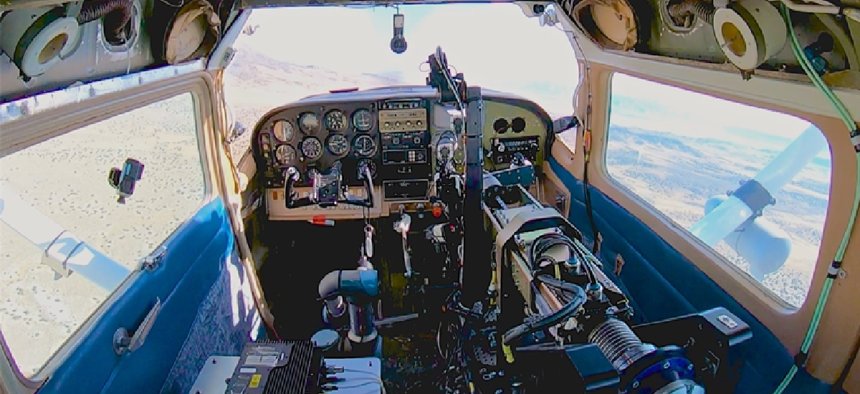ROBOpilot turns manned aircraft to drones in first 2-hour flight
A modular mechanical "pilot" recently completed a two-hour flight at Dugway Proving Ground in Utah.
A mechanical pilot recently completed a two-hour flight at Dugway Proving Ground in Utah.
ROBOpilot, a collection of mechanical arms, cables, pumps and computer equipment, interacts with an aircraft the way a human pilot would – pulling on the yoke, pushing on the rudders, flipping switches and reading dashboard gauges, but with computer vision. It gets data from GPS and situational awareness sensors and analyzes it to make flight decisions. The project is the result of a collaboration between the Air Force Research Laboratory (AFRL) and Small Business Innovative Research (SBIR) awardee DZYNE Technologies.
While automated flights are nothing new, what's special about ROBOpilot is that the modular system can be rapidly installed in a plane for an autonomous flight without making permanent modifications to the aircraft. That means it can be swapped in and out of aircraft, avoiding the cost of permanently converting planes to unmanned aerial systems.
To install ROBOpilot, users simply remove the pilot’s seat and replace it with a frame that contains all the equipment required for controlling the plane, including actuators, electronics, cameras, power systems and a robotic arm, AFRL officials said.
“ROBOpilot offers the benefits of unmanned operations without the complexity and upfront cost associated with the development of new unmanned vehicles,” said Alok Das, senior scientist at AFRL's Center for Rapid Innovation.
“Imagine being able to rapidly and affordably convert a general aviation aircraft, like a Cessna or Piper, into an unmanned aerial vehicle, having it fly a mission autonomously, and then returning it back to its original manned configuration,” Das said.
This non-invasive approach to robotically piloted aircraft leverages existing commercial technology and components, he said. ROBOpilot incorporates many subsystems and lessons learned from previous AFRL and DZYNE Technology aircraft conversion programs.
During the past year, AFRL and DZYNE designed, built and tested ROBOpilot under a Direct-to-Phase II SBIR contract. Engineers demonstrated the initial concept in a full-motion simulator designed for advanced aviation training and certified by the Federal Aviation Administration. ROBOpilot successfully completed simulated autonomous takeoffs, mission navigation and landings in a range of conditions.
The ROBOpilot capability enables a host of defense and commercial missions, including cargo delivery, entry into hazardous environments and ISR missions, DZYNE Technologies said in its SBIR proposal.
This article first appeared on GCN, a partner site of Defense Systems.





